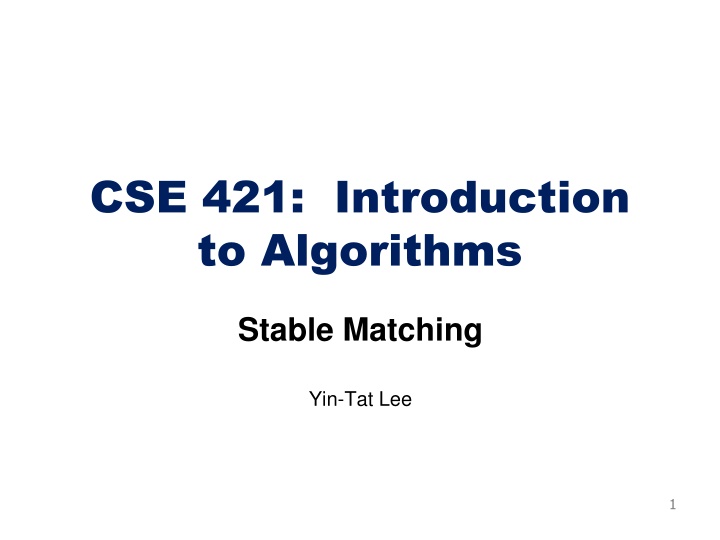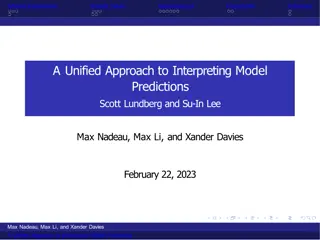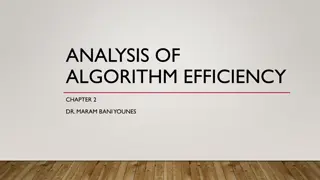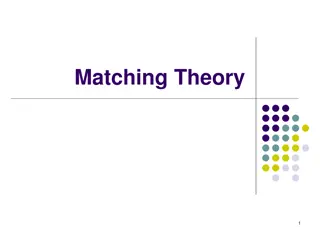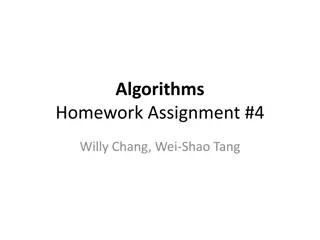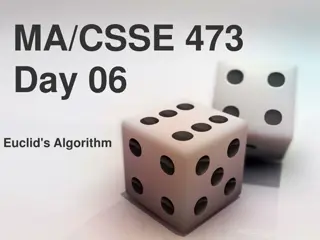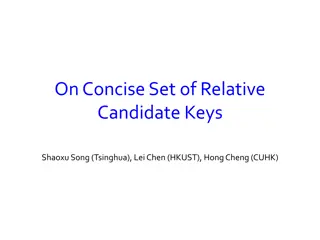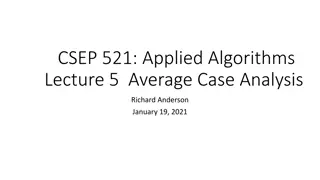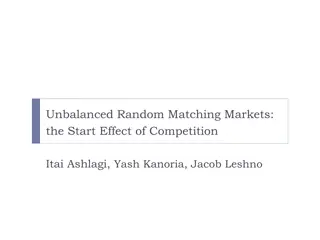Stable Matching Problem and Gale-Shapley Algorithm Overview
The content provides information on the stable matching problem and the Gale-Shapley algorithm. It covers the definition of stable matching, the workings of the Gale-Shapley algorithm, tips for algorithm implementation, and common questions related to the topic. The content also includes a summary of the last lecture on stable matching. Additionally, it outlines the propose-and-reject algorithm proposed by Gale and Shapley, emphasizing the process of initializing individuals to be free and the steps involved in the algorithm. The discussion extends to the concept of women rejecting or accepting potential partners based on their preferences.
Download Presentation

Please find below an Image/Link to download the presentation.
The content on the website is provided AS IS for your information and personal use only. It may not be sold, licensed, or shared on other websites without obtaining consent from the author.If you encounter any issues during the download, it is possible that the publisher has removed the file from their server.
You are allowed to download the files provided on this website for personal or commercial use, subject to the condition that they are used lawfully. All files are the property of their respective owners.
The content on the website is provided AS IS for your information and personal use only. It may not be sold, licensed, or shared on other websites without obtaining consent from the author.
E N D
Presentation Transcript
CSE 421: Introduction to Algorithms Stable Matching Yin-Tat Lee 1
Administrativia Stuffs Please submit to Canvas How to submit? Submit a separate file for each problem Double check your submission before the deadline!! For hand written solutions, take a picture, turn it into pdf and submit Guidelines: Always prove your algorithm halts and outputs correct answer You can collaborate, but you must write solutions on your own You CANNOT search the solution online. Tips: Rewrite your proof. (I often rewrite my proof many times.) Explain sol n to a friend. Let him be an adversary to ask you questions. Sanity Check: Make sure you use assumptions of the problem Don t write full program. Use pseudo code. 2
Suggested Guideline Algorithm: If you can reduce the question into a solved problem, Just use it. (It prevents mistakes and saves time.) For example, for stable matching, explain What man and woman are corresponding to What their preference are. How convert the stable matching to what we asked in the question. If the algorithm is similar to algorithm we teach in class You can simply explain what is the difference. Make sure your description is not ambiguous. Runtime: Make sure the answer is concise. Correctness: Okay to use a bullet format like my proof. 3
Last Lecture (summary) Stable matching problem: Given ? men and ? women, and their preferences, find a stable matching. For a perfect matching ?, a pair ?-?is unstable if they prefer each other to their match in ?. Gale-Shapley algorithm: Guarantees always finds a stable matching by running at most ?2 proposals. Main properties: Men go down their lists Women trade up! 4
Questions Q: How to implement GS algorithm efficiently? Q: If there are multiple stable matchings, which one does GS find? 5
Propose-And-Reject Algorithm[Gale-Shapley62] Initialize each person to be free. while (some man is free and hasn't proposed to every woman) { Choose such a man m w = 1st woman on m's list to whom m has not yet proposed if (w is free) assign m and w to be engaged else if (w prefers m to her fianc m') assign m and w to be engaged, and m' to be free else w rejects m } 6
A Preprocessing Idea Women rejecting/accepting. Does woman w prefer man m to manm'? For each woman, create inverse of preference list of men. Constant time access for each query after O(n) preprocessing per woman. O(n2) total reprocessing cost. 6th 7th 8th 1st 8 2nd 3 3rd 4th 1 5th Amy 5 6 2 Pref 7 4 6 7 8 1 2 3 4 5 Amy 7th 3rd 1st Inverse 4th 8th 2nd 5th 6th Amy prefers man 3 to 6 since ???????[?] = ? <? = ???????[?] for i = 1 to n inverse[pref[i]] = i 7
Propose-And-Reject Algorithm[Gale-Shapley62] Have a linked list to store free man Explained this is not needed Initialize each person to be free. while (some man is free and hasn't proposed to every woman) { Choose such a man m w = 1st woman on m's list to whom m has not yet proposed if (w is free) assign m and w to be engaged else if (w prefers m to her fianc m') ?????[?] store how many women ? proposed ?(1) time ?(?2) iter ?[?,?] store the rank of ? in the ? preference list assign m and w to be engaged, and m' to be free else w rejects m } 8
Questions Q: How to implement GS algorithm efficiently? Q: If there are multiple stable matchings, which one does GS find? 9
Understanding the Solution Q. For a given problem instance, there may be several stable matchings. Do all executions of Gale-Shapley yield the same stable matching? If so, which one? An instance with two stable matchings: A-X, B-Y. A-Y, B-X. (man optimal) (woman optimal) 1st 2nd 1st 2nd A Y X X A B B X Y Y B A 10
Man Optimal Assignments Definition: Man m is a valid partner of woman w if there exists some stable matching in which they are matched. 1st 2nd 1st 2nd two stable matchings: A-X, B-Y. A-Y, B-X. A Y X X A B B X Y Y B A Man-optimal matching: Each man receives the best valid partner (according to his preferences). Simultaneously best for each and every man. Claim: All executions of GS yield a man-optimal matching, which is a stable matching! No reason a priori to believe that man-optimal matching is perfect, let alone stable. 11
Man Optimality S m-w m -w . . . Claim: GS matching S* is man-optimal. Proof: (by contradiction) Suppose some man is paired with someone other than his best partner. Men propose in decreasing order of preference some man is rejected by a valid partner. Let m be the man who is the first rejected by a valid partner, and let w be the women who is first valid partner that rejects him. Let S be a stable matching where w and m are matched. In building S*, when m is rejected, w forms (or reaffirms) engagement with a man, say m , whom she prefers to m. Let w be the partner of m in S. In building S*, m is not rejected by any valid partner at the point when m is rejected by w. Thus, m prefers w to w . But w prefers m to m. Thus w-m is unstable in S. since this is the first rejection by a valid partner 12
Man Optimality Summary Man-optimality: In version of GS where men propose, each man receives the best valid partner. w is a valid partner of m if there exist some stable matching where m and w are paired Q: Does man-optimality come at the expense of the women? 13
Woman Pessimality Woman-pessimal assignment: Each woman receives the worst valid partner. Claim. GS finds woman-pessimal stable matching S*. Proof. Suppose m-w matched in S*, but m is not worst valid partner for w. There exists stable matching S in which w is paired with a man, say m , whom she likes less than m. Let w be the partner of m in S. m prefers w to w . Thus, m-w is an unstable in S. man-optimality of S* 14
Questions Q: How to implement GS algorithm efficiently? We can implement GS algorithm in O(n2) time. Q: If there are multiple stable matchings, which one does GS find? It finds the man-optimal woman-pessimal matching. 15
Fairness Issue Proposers get a better result. Be proactive! The G-S algorithm looks innocent, turns out to be bloody biased. To design an algorithm, speed is not everything! Efficiency (every one get matched) Fairness (do not bias on one-sided) Truthfulness (lying on your preference does not help) Example: http://www.spliddit.org/ 16
